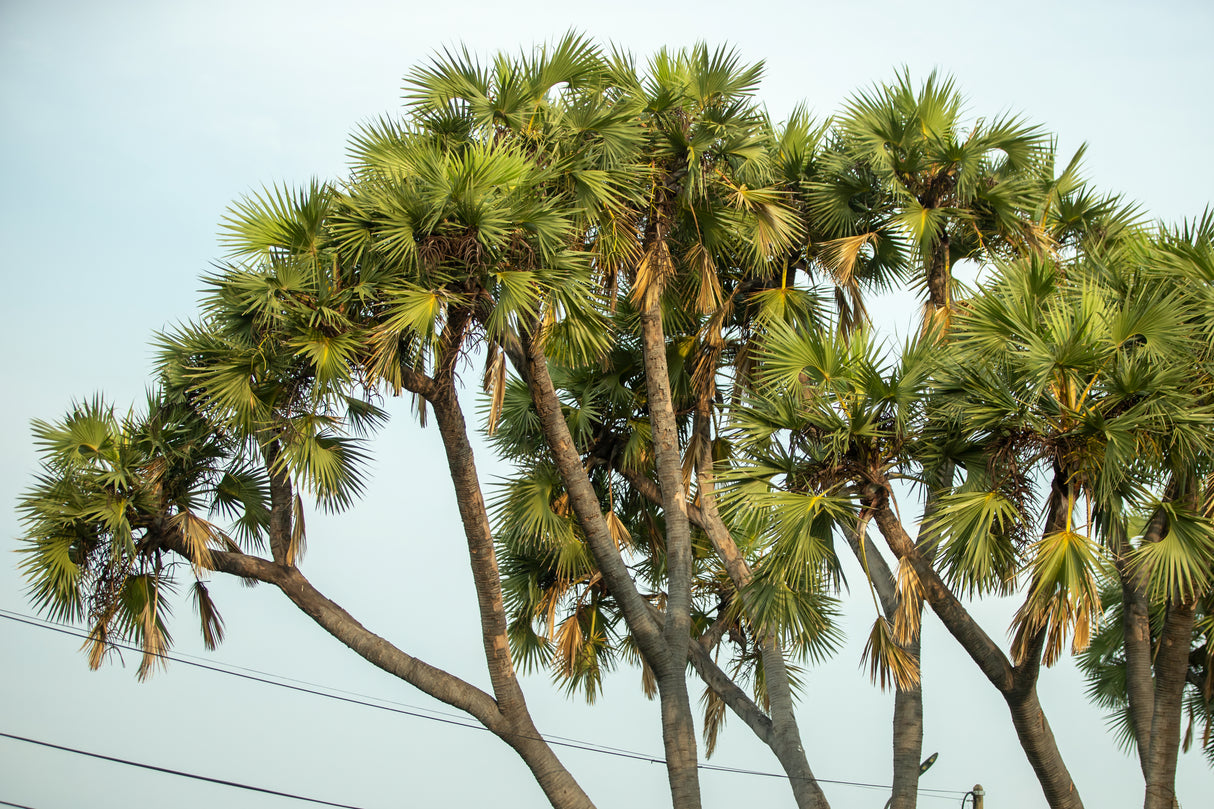Description
Description
The Hyphaene thebaica, commonly known as the Doum Palm or Gingerbread Palm, is a hardy, drought-tolerant palm native to North Africa and the Middle East. Known for its distinctive, branching trunk and fan-shaped green leaves, this palm grows up to 9–15 meters tall. It produces edible, reddish-brown fruit with a fibrous pulp, often compared to the flavor of gingerbread.
The Doum Palm is valued for its resilience, ornamental appeal, and traditional uses in food, medicine, and construction.
Specifications:
- Height: 9–15 meters
- Width: 3–5 meters (canopy spread)
- Native to: North Africa, Middle East
- Foliage: Fan-shaped green leaves; evergreen in tropical climates
- Growth rate: Moderate
Conditions:
- Soil: Prefers well-drained sandy or loamy soils; tolerates saline and rocky conditions
- Light: Full sun
- Water: Low; highly drought-tolerant once established
- Climate: Thrives in arid, semi-arid, and tropical regions
Additional Features:
- Trunk: Distinctively branched, a rare characteristic among palms
- Fruits: Edible, reddish-brown fruit with fibrous pulp; used in traditional snacks and drinks
- Uses: Ideal for landscaping in arid regions, erosion control, and ornamental planting
- Spacing: Plant 5–7 meters apart for individual displays or group plantings
- Low Maintenance: Requires minimal care; prune old fronds for a tidy appearance
- Pest Resistance: Naturally resilient; monitor for scale insects in stressed conditions
- Wildlife Attraction: Fruits attract birds and mammals; provides shelter for desert animals
- Cultural and Economic Significance: Fruits, leaves, and trunks are used in traditional medicine, weaving, and construction
The Doum Palm is a versatile and enduring tree, perfect for enhancing arid landscapes with its striking form, ecological benefits, and traditional uses while requiring minimal maintenance.
Delivery Information
Delivery Information
We offer flexible delivery options to ensure your tree arrives in perfect condition, whether you're located nearby or on the other side of the world.
- Domestic Deliveries:
We provide reliable delivery services across the country, utilizing our fleet of specialized trucks and train freight networks. Whether you're in a metropolitan area or a remote location, we ensure your trees arrive safely and efficiently. - International Deliveries:
For our global customers, we coordinate delivery via sea freight. With 30+ years of exporting experience, every tree is carefully prepared to meet international biosecurity standards and packaged for safe transport to its destination.
Our team will work closely with you to arrange the most suitable delivery method based on your location, project timeline, and tree size. No matter where you are, we ensure a seamless delivery experience.
Have additional questions? Contact us to discuss your specific delivery requirements!
FAQ's
FAQ's
How are ex-ground trees prepared for delivery?
All ex-ground trees are carefully dug with their rootball intact to preserve the root system and minimize transplant shock. Each tree is stabilized and treated with specialized solutions to promote health during transit. The rootball is wrapped to retain moisture and protect it from damage, and water crystals are added to provide essential nutrients and hydration for the journey. These meticulous preparations ensure your tree remains healthy and ready for planting, whether it’s traveling across the country or overseas.
How long does delivery take?
Delivery times vary depending on your location and the size of your order. Domestic deliveries typically take 1–2 weeks, while international shipping may take several weeks depending on the destination. Contact us for specific timelines.
Are there minimum order quantities for delivery?
For local and nationwide orders, there are no strict minimums, though delivery costs may vary based on order size. For international orders, a minimum quantity is often required to optimize freight efficiency. Contact us to discuss your needs.
Do you provide installation services?
While we focus on the supply and delivery of trees, we can connect you with trusted landscaping partners who specialize in tree installation and site preparation.
Can I visit your farms to select trees?
Yes, we welcome visits to our farms by appointment. Seeing the trees in person allows you to select the perfect specimens for your project. Contact us to schedule a visit.



 Inspection available upon request
Inspection available upon request
 Photos are of example stock
Photos are of example stock
 International Delivery Available
International Delivery Available
 Available For Export
Available For Export
